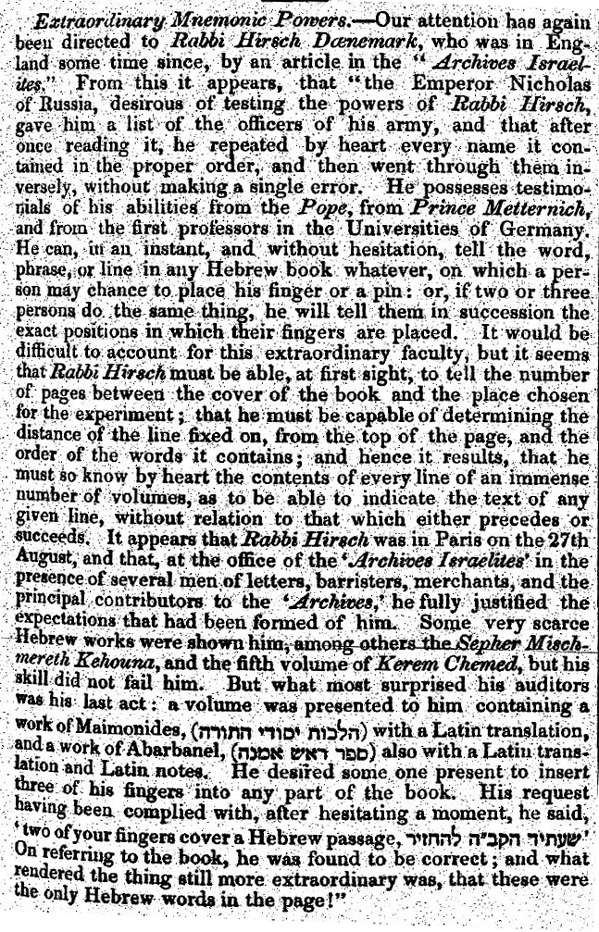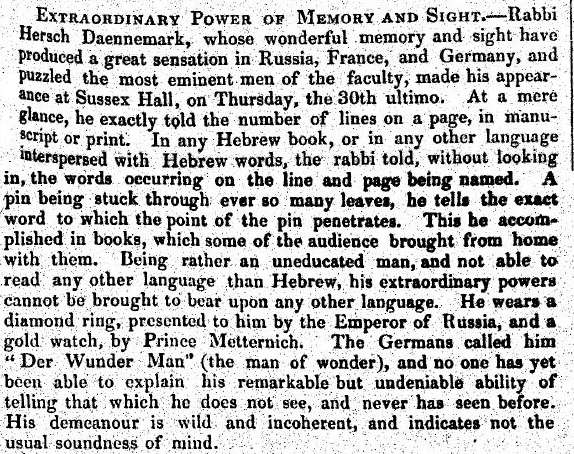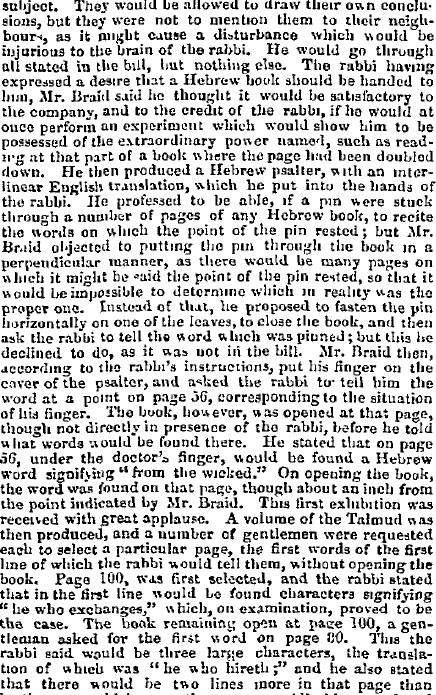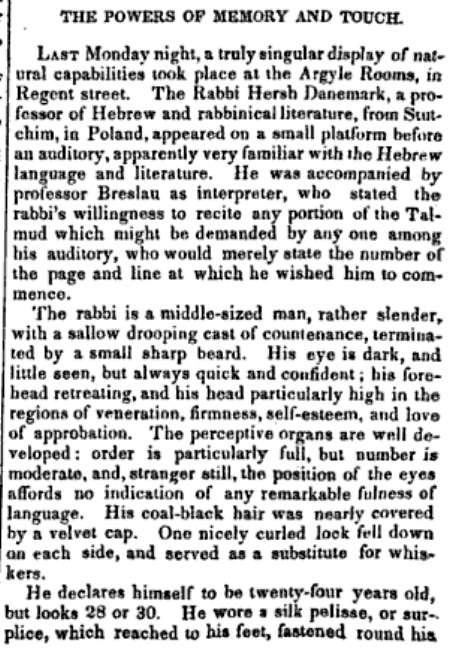This was the clipping:

I came across another clipping in the same periodical and realized that this Hirsch Daenmark was still at if a few years later (August 7, 1846):

so I decided to dig a little deeper. A much fuller account was printed September 9, 1846 in the Manchester Guardian. As you can see, the exhibition seems to have been billed as a supernatural demonstrator. The reporter found that it did seem to exhibit his extraordinary memory, but no supernatural powers:



The January 7, 1875 issue of The Academy referred back to Rabbi Hirsch Denmark in an review of a book about memory:


This article notes that Prosper Lucas wrote about Hirsch Denmark, and indeed he did. Several pages of his 1847 book Traité philosophique et physiologique de l'hérédité naturelle are about Hirsch Denmark (413-419):

To summarize Lucas's account as best as Google Translator was able to provide: Hirsch Denmark is a great example [of Lucas's thesis about heredity), because of the public nature of his cases, and the empirical reality of his phenomenon. He arrived in Metz in August of 1842 bearing letters from the Pope, Prince Metternich and famous professors in Germany. He is a Polish Jew, average looking, and aged 34, and he appears very nervous. He said that he first became aware of his strange power at age 12. He considers it a gift from God, sort of a combination of the natural and the supernatural. On the one hand, he acknowledged having a phenomenal memory. On the other, he claimed to be able to do it with works which were unfamiliar to him. He refers to himself as "Der Wundermann."
He gave three demonstrations in Metz. The first one was on August 2, and was attended by the Chief Rabbi and some Hebrew scholars, the second at the Seminary where the teachers all knew German and Hebrew, and the third in a private home, attended by several notables. Next follows a description of the Talmud, and notes that it consists of 36 volumes (bibliophiles are welcome to recognize the particular edition). The following were how the demonstrations were conducted:
1. He has people look at the book and affirm that there was nothing suspicious about the book that could indicate that there was a trick.
2. Hirsch asked someone to to place a finger or pin inside a closed book, which is then turned on its side. He then said which word the finger was covering, or if it was covering white space.
3. He asked several people give a page number and designate a few lines from the top or bottom of the page, either text and commentary. In one case he was asked to read a certain line on page 38, and it wasn't what he had said. Then he told them that there was a misprint in the page number, and it should be on the following page, and indeed it was.
4. He'd have someone put his ear on a page, and he could tell which words were covered by the ear. Then he could do the same with several pages closed together.
5. More of the same.
6. "
7. They opened a book at random, and stuck a pin in. He was asked to tell which words were at that place in pp 58-71 of the volume. He would also indicate where it crossed no word. Sometimes he would recite the word, and then also add what the commentaries on the page said about the word.
When he quoted a verse (ie, if the place landed on a biblical verse) he'd repeat the entire verse.
8. A Hebrew translation of the New Testament was brought to him. After reading it he was able to perform the finger experiment as well.
9. Gerson Levy (1784-1864) produced a Hebrew manuscript written in the Hebrew cursive used by Polish Jew, but it also contained square Hebrew used in printing. If someone's finger was on the cursive, he indicated that they should put it elsewhere, where the other kind of script was and he was able to perform. He also was able to do it on other books provided by Levy that he was unfamiliar with.
One thing to note is that before performing, he would always touch the volume and some of its pages. Asked if it would suffice if he could touch a person in contact with the book, he said that he didn't know, never having tried it.
When a book was placed on top of the Bible, he hesitated for some time, and then began to read the designated line. He was then asked to do it without touching the Bible, but refused. Finally he agreed to do it touching the hand of someone touching the Bible with his handkerchief.
At this point the author footnotes that in his opinion his insistance on touching the Bible was because of his belief in the supernatural aspect to his ability. He was able to do this, although sometimes he made small errors, such as coming to the line above or below the one he meant,
Lucas says he will omit the accounts of how he triumphed before the Pope in Rome, although he does mention that Hirsch was given a Hebrew manuscript in gold letters from the Vatican library, and succeeded.
Any noise in the room caused Hirsch Denmark to act like he was in pain. He insisited on only performing indoors, and required total silence.
Lucas concludes the account by noting that Denmark told him that he has a ten year old son in St. Petersburg with similar, or even more remarkable abilities, and this was demonstrated before the Czar of Russia.
At least, that is a sense of what it was about.
I looked a little deeper and saw that there was an account of him as early as 1839. The following was printed in The Family Magazine (published in Cincinnati, but this does not mean that Denmark had visited America. The demonstration was at a popular venue in London):




This is all that I've been able to learn thus far. I will add a new post if I learn more.
Finally, below is a famous article "Mnemonic Feat of the Shass Pollak" by George Stratton in the third issue of the 1917 Psychological Review (24):
